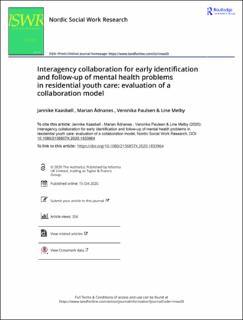| dc.contributor.author | Kaasbøll, Jannike | |
| dc.contributor.author | Ådnanes, Marian | |
| dc.contributor.author | Paulsen, Veronika | |
| dc.contributor.author | Melby, Line | |
| dc.date.accessioned | 2021-03-16T10:34:22Z | |
| dc.date.available | 2021-03-16T10:34:22Z | |
| dc.date.created | 2020-10-16T12:56:29Z | |
| dc.date.issued | 2020 | |
| dc.identifier.issn | 2156-857X | |
| dc.identifier.uri | https://hdl.handle.net/11250/2733591 | |
| dc.description.abstract | Despite high levels of mental disorders among young people living in residential youth care (RYC) institutions, only a small percentage of these children receive help from mental health services. The aim of the present study is to explore the usefulness of an inter-agency collaboration model from the perspective of service providers, and to investigate factors that promote and hinder effective inter-agency collaboration around early identification and follow up of mental problems and disorders among youth in residential care. A purposive sample of 16 professionals in three RYC institutions and related child and adolescent mental health services and child welfare services that were involved in piloting the collaboration model was recruited. Semi-structured individual and group interviews were conducted, and a thematic analysis was conducted to identify key themes. The results suggest that the collaboration model promoted increased awareness on mental health issues and a greater systematic inter-agency collaborative effort in assessing and following up the mental health of children and adolescents in RYC institutions. However, there were major challenges related to central elements of the collaboration model; the conduction of the multidisciplinary meeting within the deadline of three weeks, and participation of child welfare services-providers at the multidisciplinary meeting. Further dissemination of the collaboration model merits further consideration of the choice of screening assessment battery due to the lack of participation from teachers and parents, the time limit of three weeks and measures to increase participation from the municipal child welfare services. | en_US |
| dc.language.iso | eng | en_US |
| dc.publisher | Routledge | en_US |
| dc.rights | Attribution-NonCommercial-NoDerivatives 4.0 Internasjonal | * |
| dc.rights.uri | http://creativecommons.org/licenses/by-nc-nd/4.0/deed.no | * |
| dc.title | Interagency collaboration for early identification and follow-up of mental health problems in residential youth care: evaluation of a collaboration model | en_US |
| dc.type | Peer reviewed | en_US |
| dc.type | Journal article | en_US |
| dc.description.version | publishedVersion | en_US |
| dc.source.journal | Nordic Social Work Research | en_US |
| dc.identifier.doi | 10.1080/2156857X.2020.1833964 | |
| dc.identifier.cristin | 1840141 | |
| dc.description.localcode | © 2020 The Author(s). Published by Informa UK Limited, trading as Taylor & Francis Group. This is an Open Access article distributed under the terms of the Creative Commons Attribution-NonCommercial-NoDerivatives License (http:// creativecommons.org/licenses/by-nc-nd/4.0/), which permits non-commercial re-use, distribution, and reproduction in any medium, provided the original work is properly cited, and is not altered, transformed, or built upon in any way. | en_US |
| cristin.ispublished | true | |
| cristin.fulltext | original | |
| cristin.qualitycode | 1 | |

